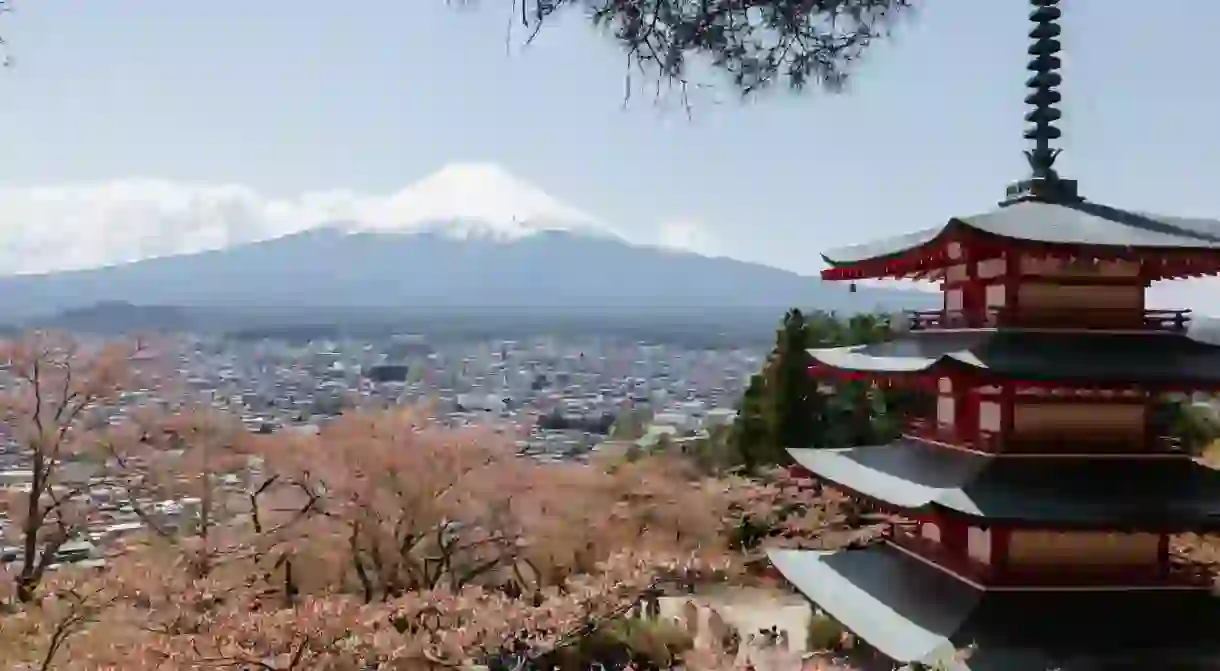A Photographic Journey to Chureito Pagoda, the Iconic Symbol of Japan

When it comes to images of Japan, they don’t get much more iconic than the image of the vermillion Chureito Pagoda backdropped by the snow-capped Mt. Fuji.
Sitting on the mountainside, looking down on Fujiyoshida City, the Chureito Pagoda is a five-storied, lacquered pagoda, part of Arakura Sengen Shrine, which was built in 1963 as a peace memorial. Backdropped by Mt. Fuji, it’s a ubiquitous symbol of the beauty of Japan’s unique architecture and stunning nature; however, it’s most beautiful in spring when the area is surrounded by soft pink cherry blooms in full bloom.


The pagoda is located around 400 steps up the mountain from the main shrine site, but there’s plenty to see along the way, including unparalleled views of Mt. Fuji. During the spring, locals and international visitors flock to the area to partake in a number celebrations typically held over the weekend.

In early April when the 650 or so trees hit peak bloom, the site is home to a number of festive events, which include pop-up restaurants serving up seasonal snacks. If you’re lucky, you may catch a live music performance on the plateau overlooking Mt. Fuji or witness a traditional ceremony held on the main shrine grounds.

From the mountain foothills is where you enter the sacred shrine site; as you pass through the towering torii gates, you’ll see a purification fountain filled with crystal clear water. To purify yourself before entering the site, simply take one of the long handled ladles, fill it with water and pour it over your hands. Some people also use the water to purify their mouths, too, by cupping the water in their hands and bringing it to their mouths and washing it out before spitting it into the trough below; this isn’t mandatory, however.


Once you get to the main shrine you can make a prayer by throwing a coin into the donation box in the offering hall, then bowing twice and clapping twice. For more tips on how to worship at a Shinto shrine, be sure to consult our detailed guide.


Nearby you’ll find a collection of wooden blocks known as ema – they’re essentially little prayer plaques that can typically be bought from a store on the shrine grounds. On the empty back of the ema you can write your wishes (in whatever language, Japanese isn’t necessary) and leave it hanging by the shrine.

If you’ve missed the cherry blossom season, the area surrounding the shrine is also stunning in autumn as well, when the foliage surrounding the shrine and pagoda transforms the mountainside into fields of vibrant red and gold. This typically happens during late October and in early weeks of November.

Be warned that if you want to avoid crowds, it’s safest to visit during the week, because given that this site is part of the Fuji Five Lakes region (also known as Fujigoko) it’s an incredibly popular tourist destination. That said, if you have a day to spare, it’s still well worth the journey.

An easy day trip from central Tokyo, the Arakura Sengen Shrine is a two-hour bus ride from Shinjuku Station. Travelling by train is also possible, although it takes a little longer. To get to the area by train, catch the Chuo Line from Shinjuku Station, then switch to the Fujikyuko Line at Otsuki Station before getting off at Shimo-Yoshida Station; from here, the shrine is a scenic ten-minute walk.














